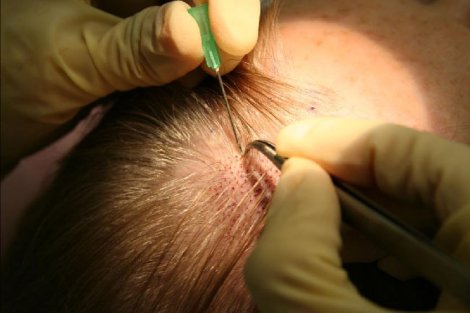Surgical Hair Transplantation

If a person desires to escape hair loss there are different ways to do so and a good specialist usually advises the best treatment for an individual case. Some patients do fine if they just change a diet, start taking more vitamins required for hair growth. The others should overcome certain life conditions like stress, disease, etc. which leaded to hair loss. In some cases drugs do a really good job: after six months with Propecia many men have noticed that their hair was restored and stopped falling out.
However, there are cases when surgical hair transplantation is the best decision. Surely there are some advantages that make people think the surgery is the best way to go. This procedure usually helps to re-grow hair permanently especially at the hair line with which many drugs are helpless. The new hair keeps growing naturally and even hair stylists do not notice whether they deal with transplants or person’s natural hair. As the rest of the hair on the scalp, transplants grow and require care, haircuts and styling.
The hair restoration surgery should be done by physicians only. The procedure is very complicated and takes a lot of time and skills of even highly qualified stuff. Only a minority of hair restoration surgeons succeed in doing the transplantation.
During the operation the physicians take hair from the back of the head and move it to the balding areas of the top and front. This hair is bald resistant and is considered to be dominant donor hair that successfully grows after transplantation for the lifetime.
The idea of hair transplantation was first introduced by Dr. Okuda from Japan in 1939. He offered to move hair to repair scarred eyelashes and eyebrows. It was closely connected to his job: Dr. Okuda was working with severely burnt patients and transplanted round pieces of skin with hair follicles from the permanent hair-bearing areas into small round openings of scalp. The hair continued to grow after the operation. The surgeon’s discovery was published in a Japanese medical journal, but unfortunately he died during World War II and his research and experience were lost.
The modern technology which is similar to what was offered by Dr. Okuda was discovered by Dr. Norman Orentreich in New York in the beginning of 1950’s. Many doctors of that time did not believe that the operation was possible this is why Dr. Norman’s research was rejected by several medical journals before it finally was accepted by the Annals of the New York Academy of Science in 1959.
The study has shown that hair keeps its characteristics and grows in the new area as it used to before the graft was transplanted. This is why only hair from the back of the scalp is sufficient to replace the balding areas at the front and top of the scalp. Unfortunately not every person can qualify for the surgery, but only those who have enough of donor hair in the back of the scalp.
Over the decades the hair transplantation surgery has developed a lot. Modern technologies allow making the process faster, more accurate and less painful. If Dr. Orentreich has come up with the optimal graft of 4 mm, modern surgeons can move micrografts with 2-3 hair follicles. This allowed expanding the number of candidates who could qualify for the surgery because these little areas can be taken from almost everybody.
Hair transplantation surgery sometimes ends up with side-effects like mild pain, discomfort, swelling and formation of scabs over the grafts, but all of them fade away with time. Such serious problems as bleeding, scarring and infection happen very rarely. Thanks to the advanced technologies the hair surgeries are comfortable and the results of them pleased many patients.
Mel Tyler
Posted on July 6, 2009
Filed Under Hair Loss News and Statistics, Hair Loss Treatments
Comments
Leave a Reply
